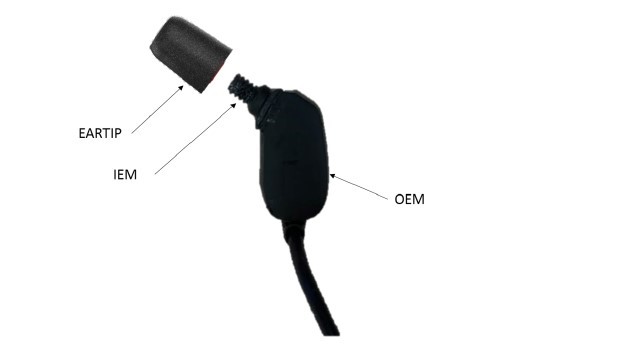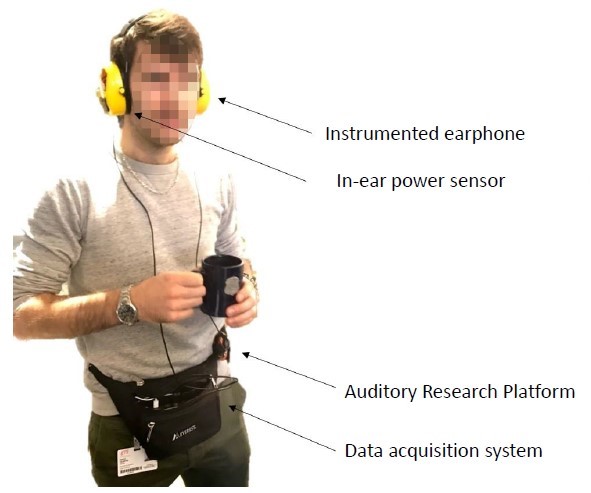|
|
| 你的身体也能发电吗?用于检测下颌关节活动功率的移动入耳式功率传感器 | MDPI Micromachines |
|
论文标题:Mobile In-Ear Power Sensor for Jaw Joint Activity
期刊:Micromachines
作者:Jacob Bouchard-Roy, Aidin Delnavaz and Jérémie Voix*
发表时间:27 November 2020
DOI:10.3390/mi11121047
微信链接:https://mp.weixin.qq.com/s/HopE9WDguSLUHensqoSyGQ
期刊链接:https://www.mdpi.com/journal/micromachines
近年来,随着科技的发展,各类电子设备也层出不穷。消费者对于电子产品的需求,也在逐步升级,比如轻松可携带,或者是智能快捷,更能满足用户需求。面对这些市场期待,一时间内,各种智能可穿戴设备出现了爆炸式增长。然而目前这些设备的电池需要不定期地进行充电,而且续航时间也不长,这也是这些电子设备普遍存在的缺点之一。那么,是否存在可以代替电池的选择性能源,让可穿戴设备自供电呢?针对这一问题,研究者们提出了利用人体运动收集能源的想法。
以助听器为例,在2013年,有研究者第一次提出,由于助听器是耳戴式的,我们可以通过耳道运动收集能源的想法 [1]。他们提出了两种不同的机制——电磁和压电,来收集与这种运动相关的能量。其后,研究者们进一步通过可穿戴式功率传感器对6名测试者进行测试,结果发现,6名受试者在几分钟内咀嚼一顿饭,单个耳道可获得的平均功率为26.2 mW [2]。既然人们吃饭咀嚼都可以获得能量,那么人体头部的其他活动是否也可以提供能量呢?
近期,来自加拿大高等工程技术学院的Jérémie Voix博士等人在期刊Micromachines发表了一篇文章,介绍可用于检测下颌关节活动功率的移动入耳式功率传感器。这篇文章的目的在于测试主要的下颌活动 (除了咀嚼,还包括吞咽、咳嗽和说话) 可以提供的能量容量,以进一步收集能源,给耳戴式电子设备供电提供更多的研究可能。
作者设计了一种移动入耳式的功率传感器,这种传感器由一对耳罩和一根头带 (供测试者将传感器戴在头上) 组成 (图1)。右耳罩由预先安装的可充气耳塞组成,耳塞有三个级别:短、中、长。耳塞内使用了液压回路,包括液压管、阀门和压力传感器,以水充入。此外,该耳罩内也包含了压力信号调节、放大和数据转换的电路。研究者使用注射器将水注入液压回路,然后通过右耳罩的电线将信号传输到数据采集和记录系统中。

图1. 入耳式功率传感器:右耳罩的充气耳塞和相关的液压回路。
左耳罩配备了一个耳机,其中有两个微型麦克风:入耳式麦克风 (IEM) 和外耳式麦克风 (OEM)。如图2所示,耳机尖端使用了一个通用的泡沫,以增强入耳配戴时的舒适性。

图2. 入耳式功率传感器:右耳罩的充气耳塞和相关的液压回路。
同时,作者所在实验室开发了一个听觉研究平台(ARP3.0) 及其相关数据采集系统,用于采集音频和压力信号。该ARP平台使用触觉屏幕和Windows操作系统,测试期间被放置在被测试者携带的腰包内,如图3所示。另外,还配备了一个可充电电池,也被放在腰包中,通过一根线连接着耳罩,为压力传感器和模拟前端供电。

图3. 佩戴入耳式功率传感器设备和听觉研究平台的测试对象。
在这项研究中,作者选择了三名耳道和身体状态良好的男性受试者,每个测试对象都被要求戴上耳罩及其腰部的ARP袋。测试过程中,测试对象可以进行日常工作,整个测试持续了大约三个小时,其中包括午餐时间。实验结束后,收集ARP平台记录的信号数据,用于后续计算。
作者通过对下颌关节活动检测的结果,进行算法计算,主要针对咀嚼、吞咽、咳嗽、说话四种主要的下颌活动类型,所得的瞬时功率结果如图4所示。

图4. 通过内部声音检测算法检测到的每个颌骨关节活动相关的瞬时功率:(a) 咀嚼;(b) 吞咽;(c) 咳嗽;(d) 说话。
结果显示,这四种活动类型的瞬时功率变化与人体正常活动的规律节奏是一致的。如图4a,与咀嚼相关的瞬时功率变化比较平稳,这是因为人在吃饭时通常保持平稳的咀嚼节奏; 然而与说话相关的功率变化非常不稳定 (图4d),这是因为测试者说话的速度,分贝以及说话的内容对测试结果都有非常大的影响;由于吞咽具有低频特性,因此瞬时功率表现出更离散的特性 (图4b);最后,咳嗽的功率图由于其自发发生而显示出更明显和孤立的峰值 (图4c)。
接下来,作者将图4记录的测试结果,通过下颌功率算法计算,得到了内部压力 (Wi) 和弹性变形 (We) 分量产生的平均功率以及每个颌骨相关活动的持续时间,结果如图5所示。

图5. 三个测试对象每个下颌关节活动的平均功率。
计算结果表明,咀嚼在测试对象中具有最长的持续时间序列,持续时间从5分钟到21分钟不等,谈话活动排在第二位,所有测试对象的谈话时间都不到8分钟。咳嗽排在最后,通常只持续几秒钟。另外,结果还发现,三个测试对象之间的平均功率的分类也是不同的。尽管如此,我们可以看到最大能量 (平均功率×持续时间) 的获得者是咀嚼活动 (除了受试者2,他的谈话产生的能量和咀嚼一样多)。
最后,作者得出结论,咀嚼在测试对象的耳道中可以产生平均3.8 mW的功率,在所有类型的颌骨活动中具有最大的能源潜力。作者相信,在未来,通过压电效应可以成功实现动能到电能的转化,这也为实现通过人体运动为可穿戴电子设备 (比如助听器) 供电提供了可能。
References
1. Delnavaz, A.; Voix, J. Energy Harvesting for In-Ear Devices Using Ear Canal Dynamic Motion. IEEE Trans. Ind. Electron. 2014, 61, 583–590, doi:10.1109/TIE.2013.2242656.
2. Bouchard-Roy, J.; Delnavaz, A.; Voix, J. In-Ear Energy Harvesting: Evaluation of the Power Capability of the Temporomandibular Joint. IEEE Sens. J. 2020, 20, 6338–6345, doi:10.1109/JSEN.2020.2976925.
Micromachines(ISSN 2072-666X; IF 2.523) 是一个与微纳米技术领域相关的国际型开放获取期刊,期刊范围涵盖微纳米结构、材料、设备和系统等各方面的研究与应用。目前期刊已被SCIE (Web of Science),Ei Compendex,Scopus等数据库收录。Micromachines采取单盲同行评审,一审周期约为12.5天,文章从接收到发表仅需1.9天。
Background
Most hearing aids rely on electrochemical batteries to operate, which involves either replacing or recharging them periodically, resulting in limited energy autonomy and reduced comfort to users. A possibility to overcome these disadvantages is to harvest energy from the human body or the proximate environment. Several types of hearing aids whose chargers are powered by alternative energy sources have already been developed. A methanol-based micro fuel cell has been used for the instant charging of hearing aid batteries. Moreover, solar-powered chargers help to make hearing aids more affordable to the consumer and less pollutant to the environment. However, these technologies have done nothing to improve the energy autonomy of hearing aids.
Methods.
The idea of energy harvesting from earcanal dynamic movements was first presented by the authors in 2013. Two different mechanisms (electromagnetic and piezoelectric) were proposed to harvest energy associated with such movements. The prototypes were tested for a single test subject. Based on the results, the energy capability of the earcanal was subsequently roughly evaluated for 12 test subjects based on the extent of their earcanal deformations. The earcanal dynamic movements were later investigated more extensively by either COMSOL (Stockholm, Sweden) multiphysics finite element modeling or analytical modeling to evaluate the energy capability of the earcanal dynamic movements. A more recent study on a wearable power sensing device developed to measure the power associated with earcanal dynamic movements shows that a mean power of 26.2 mW is readily available on average for a single earcanal, based on a test in which 6 subjects chewed a meal for a period of several minutes. However, the paper does not provide information about the energy capability of the earcanal dynamic movements for other jaw joint activity nor on the long-term energy evaluation tests.This paper aims to calculate the energy capability of the main jaw joint activities, namely mastication, swallowing, coughing and talking during a 3-h earcanal dynamic evaluation test for three test subjects. The in-ear power sensor equipped with an earphone to detect jaw joint activity is presented in the next section.
Results
According to the results, 3.8 mW of power on average are expected to be available from earcanal dynamic movements, which is about 4 times greater than the power needed to run typical hearing aids.
Conclusions
Earcanal dynamic movement generated by the main jaw joint activities was investigated in this paper and found to be a promising source of energy to power hearing devices. The portable sensor device developed in this paper could successfully measure the audio and pressure signals inside the earcanal, and transmit and store the information in a mobile computer platform. The jaw joint activity detection algorithm could efficiently detect and classify the jaw activities. In addition, the analytical model of the inflated earplug inside the earcanal could estimate the available power in the form of internal pressure and elastic deformation separately. Finally, the energy capacity associated with each jaw joint activity was quantitatively evaluated and reported for three test subjects. The results show that 3.8 mW of power on average is generated in one test subject’s earcanal with chewing having the greatest energy source potential among all types of jaw activities. The conversion from kinetic energy to electrical energy can be accomplished among others via piezoelectric effects in the future. However, other human factors like ergonomics, comfort and metabolic cost of such in-ear energy harvesting devices should be thoroughly investigated in advance.


(来源:科学网)
特别声明:本文转载仅仅是出于传播信息的需要,并不意味着代表本网站观点或证实其内容的真实性;如其他媒体、网站或个人从本网站转载使用,须保留本网站注明的“来源”,并自负版权等法律责任;作者如果不希望被转载或者联系转载稿费等事宜,请与我们接洽。